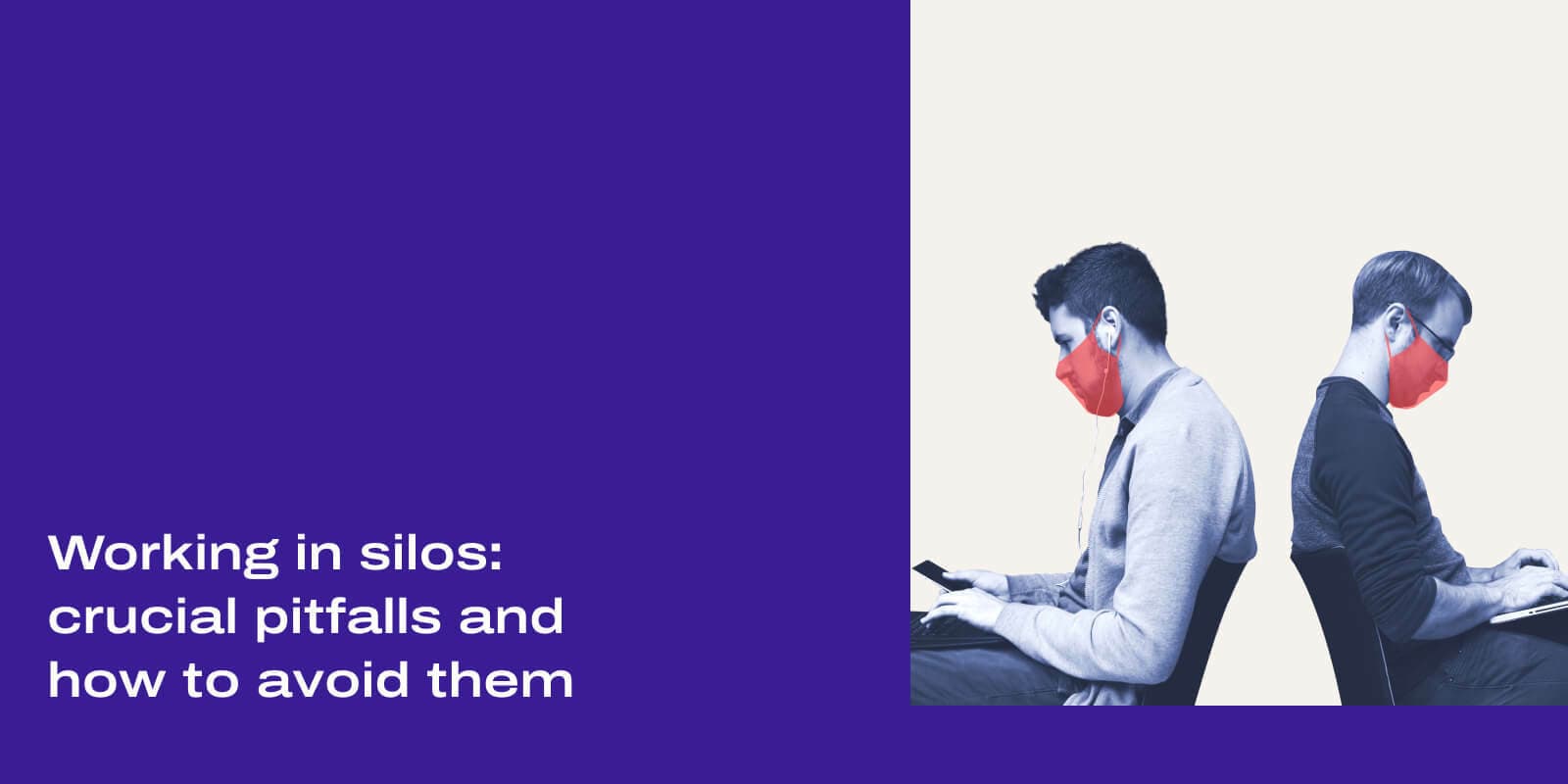
Tags
Share
As a full-time remote worker who manages a distributed team (and agencies!) across different time zones and continents, I’ve experienced my share of silos.
And they suck.
They make you (and your team and pretty much anyone you work with) unproductive, unhappy—and unlikely to play nice with others.
They’re by no means unique to remote workers (I’ve worked in offices before and we’ve had horrible silos there too), but they do tend to hit remote workers harder. It makes sense. You’re much farther away from everyone else, and it’s much easier to just not communicate.
So how can you get away from this silo mentality? How can you empower yourself and your team to be better communicators and work together more effectively?
I’ll walk you through what I’ve learned over the last few years, and hopefully, it’ll help you destroy some of these silos.
What is the silo mentality?
The silo is basically a metaphor to describe team members or departments existing or operating in isolation—instead of collaborating with others.
And the “silo mentality” is a state of mind that you can fall into, where you default to not communicating with other folks, whether on your team or outside your team.
A few easy ways to tell if you’ve got a case of silo mentality at your company: are different departments failing to share information consistently with one another? Are you noticing a lot of inefficiencies in everyone’s workflows?
If everyone’s focusing only on their specific duties, without considering wider business goals and the bigger picture, they’re working in silos.
What are the causes of silo mentality?
Silo mentality can stem from doing things a certain way because “that’s just how we do things” and sometimes, just because we’re lazy. No judgment, I’ve done it before. Communicating takes effort and it can be tempting to just… not do it.
Here are some of the main root causes of silo mentality to watch out for—and all three are preventable or fixable. (I’ll give you a number for each one if you want to skip to the tips section below to find the cure for it.)
Conflicting leadership
One of the biggest—and most challenging-to-overcome—causes of silo mentality comes from the top down, and these create organizational silos. They’re particularly tricky because they’re often enabled (even if it’s by accident) by managers and more senior folks who haven’t consciously designed processes and workflows to minimize silos.
The results of this can vary—it can be something as minor as people disagreeing about who should be responsible for certain tasks, or bigger conflicts about allocation of resources (not to be dramatic, but think of turf wars between different teams).
Fix: #1, #5
Lack of established systems and workflows
Without clear systems and tools for everyone, confusion reigns and silos thrive (especially for remote teams).
People silo themselves off, often because they don’t know what else to do—if nobody seems to be taking responsibility for a task or decision-making, you might grab it for your team even if you’re not the best people to do it (or just retreat quietly into the background).
Fix: #2, #3
Not having the right technology
If you have people working remotely across different time zones, then this one is going to be very important. People need to be able to communicate if you want to break down silos. And that includes having the technology to communicate over different channels like phone calls, video conferencing, and more. (And if you want to get fancy, might I recommend project management tools as well?)
👉 Dialpad tip:
See how ClassPass onboarded new team members—with offices all around the world!
Fix: #3, #4
Why is working in silos bad?
If for some reason I haven’t done my job and you’re still wondering why silos are bad, here are just a few of the not-so-great effects they can have on your team, your customers—and your own productivity.
Loss of productivity
Silos kill productivity because employees keep information to themselves, deliberately or otherwise, instead of making it freely accessible. Which means others have to spend time searching—or asking for it. Often, I find that people slack (or look like they’re slacking), not because they’re lazy, but because they don’t have the information or data they need to do their job. Silos can make it hard to tell the difference.
Resistance to change and a lack of innovation
If teams don’t collaborate, they can’t innovate. Without teamwork, nobody gets to share ideas and perspectives—especially important if you work on a creative team like Design or Content. (And I find that the longer you work in a silo, the harder it is to change your mindset and adapt.)
Duplicate work
When teams work in a vacuum, they don’t know what others are doing—and they run the risk of duplicating work, which wastes everybody’s time.
👉 Dialpad tip:
Dialpad makes collaboration easier by enabling document sharing during online meetings—you can even make changes in real time so that everyone’s up to date.
Low team morale
All of this—the top-down approach associated with siloed working, the negative effects of it— can make people feel like unimportant and disconnected cogs in a very large corporate machine. It’s not good for company culture, and in the end, could lead to high turnover and attrition.
A poor customer experience
Of course, one of the ultimate “bad” results for any business: unhappy customers. But “how exactly can silos affect your customer experience?”, you ask. Good question. Here’s an example.
If your Sales team and Customer Success team aren’t aligned (and I’ve seen this before, not my own team, but as a customer when I purchased software), then what your customers are promised on a demo as the deal closes—oh, let’s say you were promised an onboarding or setup service—might not get communicated to the Customer Success team.
Which then leaves your customer wondering why those teams aren’t communicating with each other. Not good for customer satisfaction.
Or, here’s another fun one. Let’s say your Marketing doesn’t tell you Customer Support team that you’re running a big promotion for 20% off all new purchases or contracts. Your customers get wind of it, and your poor Support team ends up getting a barrage of incoming phone calls because no one told them this promotion was happening. I’ve seen that one firsthand too.
So now you understand why I’m so passionate about not working in silos...
👀 Interested in hybrid work?
Grab the Hybrid Work Playbook, which includes real-life case studies and breaks down all things hybrid + remote, from building and sustaining a hybrid workforce to equipping your team for success.
How do you overcome working in silos? 5 ways to communicate better
1. Have regular alignment meetings
For remote workers, it’s even more important to keep everyone in the loop because they can easily feel excluded and miss out on information sharing as well as collaboration opportunities.
Regular meetings are a great way to prevent that. Now, I’m not advocating for unnecessary meetings because they can be huge timewasters.
You can have an asynchronous daily huddle where folks just message each other in a team thread to give a quick update (not a meeting!) or just do a brief stand-up so that the meeting doesn’t take up too much time.
This is a great opportunity to ask questions and raise issues in a collectively shared space rather than pinging individual emails back and forth (which tends to be less efficient).
You can use Dialpad to do this, and just create groups and channels specifically for teams and projects:

I truly don’t believe that you can “overcommunicate” when you’re a remote worker, and another neat thing that you can do in Dialpad is chat with folks in a channel—kind of like a temporary chat room—if you need to discuss something verbally:

We also use Dialpad Meetings for team standups—it’s nice seeing each other over video conferencing, and yes, this is probably not a scientifically backed claim, but seeing my teammates’ faces regularly helps me feel like I’m more in sync with them and less siloed.
(There's a free plan that includes video meetings and messaging, which you can sign up for in minutes here.)
By the way, did you know you can easily host and join a meeting from a web browser instead of having to download the app?

👉 Dialpad tip:
You need asynchronous ways of catching up with colleagues, especially in a global business where colleagues aren’t always online at the same time.
2. Don’t shy away from cross-team collaboration
It might be tempting to divide everyone into neat little boxes and tell them to get on with specific tasks, but cross-team collaboration is much more beneficial. As well as getting an overview of what other people are working on, it also helps everyone develop an understanding of—and an appreciation for—each other’s roles.
Some of the most successful projects I’ve ever been a part of had cross-functional teams—one or two folks from Marketing, one or two from Sales, and so on, from Design, and other teams.
There are few things that automatically break down silos, and this is one of them. We love using Miro for cross-team projects because it lets everyone contribute no matter where they’re located.
And it integrates with Dialpad so we can see each other while whiteboarding together:

3. Invest in the right tech stack
If you’re serious about smashing silos, you need to have collaboration and communication tools—especially if you have a distributed team.
For basic communication, you need to cover the channels that your team uses every day. For most people, that includes phone calls, video conferencing, and instant messaging. (If your company has a strong social presence and/or strategy, then you’ll probably also need social media management tools for channels like LinkedIn.) My best tip here is to consolidate all of those channels into one software or platform.
Dialpad is great for precisely this because it’s a unified platform—you can make a phone call, start a video meeting, and send a group or someone a message, all in the same app.

From there, you should look at the other software your company is using. Does your communication platform integrate with them? For example, Dialpad integrates with popular apps like Salesforce to automatically log activities and allow reps to make and take calls, right from inside Salesforce:

If your tools integrate with each other, it makes it much easier for everyone to keep track of metrics, whether you’re a marketer or a salesperson, and it reduces a lot of the low-value work that people are used to doing when they’re using a bunch of different systems. (Copying and pasting data used to be the bane of my existence.)
And again, I make no secret of this, but I use project management software—specifically Asana—heavily. Not everyone will need it, but if you have multiple projects and tasks going on with different teams, it’s a godsend.
4. Have a shared wiki or intranet
This is a simple—but important!—one.
Have your key company information, like work-from-anywhere and BYOD policies, employee directories, instructions for expensing things, company holidays, and so on all in an easily accessible place.
The companies I’ve worked at all use different things—I’ve used Confluence before, BambooHR, you name it. Even a Notion would be fine.
These are so useful because people can find answers to common questions on their own without emailing certain departments. While you could argue that this silos people more because it reduces the need for them to talk to each other, I’d say that this makes important information accessible and reduces the need for people to waste each other’s time with easily answerable questions. But hey, just my opinion.
5. Lead by example
This one is more for managers. If you aren’t one, congrats, you're at the end of the list and skip to the conclusion.
Lack of communication isn’t one of the “worst” causes of silos—but it’s one of the ones I hate the most. Why? Because it’s so preventable.
And for managers, you have two pretty straightforward ways to tackle this head-on: from a process standpoint, and from a management standpoint.
What processes are you putting in place to help your team collaborate better? For example, do you use asynchronous communication channels—or does everyone always have to be together in every meeting?
From a management perspective, are you sharing a unified vision and common goals regularly? Are you as a team leader practicing a collaborative communication or working style yourself, or just preaching it?
I use Asana probably the most out of anybody and make sure to tag folks (and respond to tags!) diligently. If I’m asking my team to communicate, I have to be sure that I’m communicating just as openly.
When it comes to breaking down silos, it’s always easier when there’s leadership teams’ support and executive buy-in. If employees see that their execs are unified and committed, it will help them take the same approach.
It may seem like a small thing, but it’s key to developing an in-office and remote culture where anyone can talk to anyone and everybody feels comfortable with raising issues and making suggestions.
Improve team productivity and employee experience by avoiding working in silos
Almost everyone has to face the beast that is silo mentality at some point in their career. And sometimes it isn’t even “your fault.” Sometimes it’s someone else who’s siloed and it’s just affecting you, the bystander.
Unfortunately, you can’t just make someone see the big picture. Removing silos is often a lengthy—effortful—process. It takes time for people to break out of bad habits, and they have to always be alert and self-regulate to make sure they don’t fall back into easy patterns.
The best you can do to create a better digital employee experience is to equip yourself and your team with the right tools, make communication as easy as possible, and try to anticipate steps in your projects where people may be tempted to not communicate as rigorously. Happy silo smashing.
Need a tool to help break down communication silos for your distributed team?
Sign up for a free 14-day trial of Dialpad (it takes just a few minutes) and see how it lets your team make phone calls, have video meetings, and send instant + SMS/MMS messages—all from the same place! It takes just a few minutes to get started, and you'll be set up with a virtual phone number too. Or, take a self-guided interactive tour of the app!

